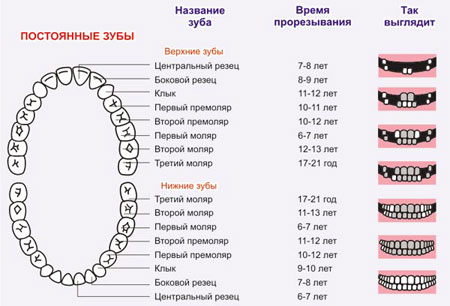Loss of milk teeth is a very important event not only for little fidgets, but also for their parents. Each tooth that falls out is a great event, which is accompanied by the arrival of the "tooth fairy" and the making of cherished desires. But how long can we wait for this great event? What kind of teeth change in children and what to do with a fallen milk tooth? In what order do the baby's milk teeth fall out and root teeth appear in their place?
Why milk teeth fall out
Many inexperienced parents believe that in babies, the entire dentition changes in one part - this is fundamentally not true. This process is gradual and individual. One should not think that they can fall out at one moment - this procedure takes much longer. As a rule, after the onset of four years of age, the child's first permanent teeth erupt - the third molars. It is after this moment that the root of the milk teeth begins to actively dissolve - and subsequently loosen. First of all, the upper part of the root is absorbed, after which the process extends to the remaining parts. How long this process lasts - it will not be possible to say unequivocally. As a result of this process, after about 1.5-2 years, milk teeth begin to leave the oral cavity. It is worth noting that about 20 teeth are replaced throughout a child's life. When do baby teeth fall out and how long does this process take?
In what order do milk teeth fall out
There is no definite order in which the milk teeth are replaced by molars. It depends on the individual characteristics of the development of the child's body. As a rule, the process of replacing milk teeth with molars begins at the age of 6. But if the loss begins six months earlier or later, you should not panic. This is a completely normal process, which is due to the individual characteristics of the child's development. Which teeth are the first to fall out in children? Here is a rough diagram of the dentition change.
- The first to begin to fall out are the central incisors of the lower jaw, the root of which begins to loosen up - usually this happens at 6-7 years of age. The loss of the lower incisors is the initial stage in replacing the milk incisors with permanent ones;
- The upper central incisors are replaced with permanent teeth when the baby is about 8 years old. At this time, the roots of the milk incisors begin to loosen. This process is somewhat longer than the loss of the lower incisors;
- The lateral incisors of the lower and change to permanent ones at about 7-8 years - the process begins with the dissolution of the root;
- The canines of the lower jaw change their status from milk to permanent at about the age of 9-9.5 years, and the changes begin from the root of the canine;
- The first molar of the lower jaw is replaced by a new tooth at about the age of 10 years. A prolapsed molar of the upper jaw occurs at about the same time;
- The second molar of the upper jaw leaves its place of residence as soon as a person reaches 10.5-12 years. The change of the second molars of the lower jaw occurs much later - as a rule, when the child reaches about 13 years of age;
- The third molars of the upper and lower jaw in a child are replaced with new ones already at a more mature stage of development - about 8-22 years. That is why they are also called "wisdom teeth".

In the majority of cases, the total duration of the process of losing milk teeth and replacing them with permanent ones lasts at least 6-7 years. In no case should you panic if your child has already reached 6 years of age, and his milk “friends” do not grow in any way and are in a hurry to give way to their constant “colleagues”. Is there a baby tooth? How long the process of changing the dentition lasts depends on the individual characteristics of the development of a particular child's body. Therefore, if your baby's milk teeth are still in place, despite the fact that he is already 7 years old, do not despair - just a further change of milk teeth will be much faster and more active. As soon as the root of the milk tooth begins to loosen, it will fall out in the shortest possible time and you will notice how a beautiful and healthy tooth grows.
What factors affect the rate of replacement of milk teeth in children
The process of loss and, accordingly, replacement of the dentition is influenced by a number of factors:
- The quality of the baby's daily diet and the presence in the menu of the required amount of useful vitamins and minerals;
- The presence of certain diseases of a chronic nature that have a negative impact on development, and the replacement of the dentition, including;
- Drinking water quality;
- An important factor is genetic predisposition. For example, if you or your spouse's milk teeth began to fall out only at the age of 8, then it is not at all surprising that your child will only at this age begin to get acquainted with all the "charms" of replacing them with indigenous ones, despite the fact that he has not one milk tooth remained.
Loss of milk teeth in children is a very individual process, its timing and duration can differ significantly for each child. Do not worry if the loss of dairy "friends" begins a little earlier or later than the above dates. In order to get rid of unnecessary anxiety, be sure to take your child to an experienced dentist.





